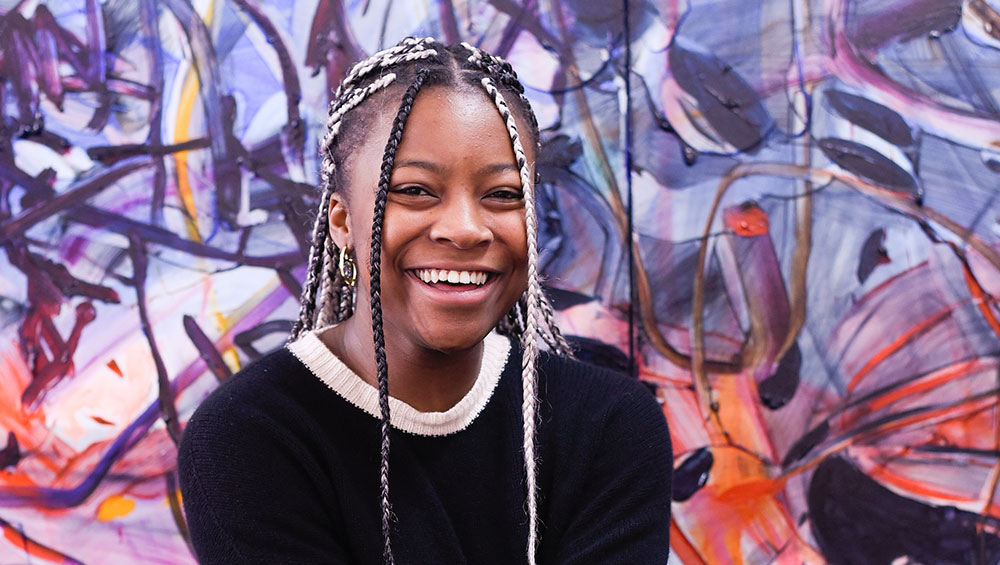
Jadé Fadojutimi. Photo © Jadé Fadojutimi 2021.
by DAVID TRIGG
Since graduating from the Royal College of Art in 2017, the British painter Jadé Fadojutimi (b1993) has become known for her large scale, colour-saturated compositions. Rhythmic, gestural marks dance across their surfaces, ebbing and flowing between abstraction and figuration to conjure a host of different moods and sensations. “While I’m painting, the harmonious unity of my senses becomes apparent,” she writes in her recent monograph, Jesture (Anomie Publishing, 2021). “They muddle together, chitter-chattering about their newfound warmth as though it’s their first connection. This first meeting seems to happen almost every day.”
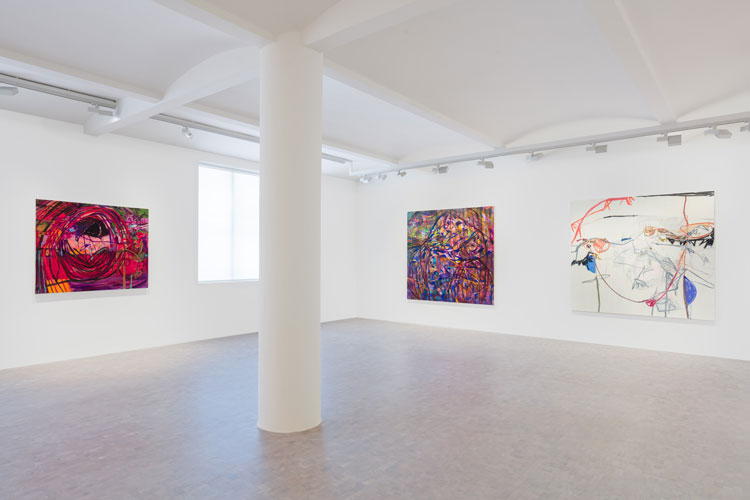
Jadé Fadojutimi, Jesture, 2020, Pippy Houldsworth Gallery, London. Photo: Mark Blower.
At the heart of Fadojutimi’s complex, multilayered images are an interrogation of identity and a quest for self-knowledge. She likens the process of painting to peering into a windowpane and seeing herself and her surroundings reflected. Notably, her singular approach evidences little engagement with art history, or even other painters (though there are many she admires). Rather, her imagery feeds off personal experiences and memories, drawing inspiration from music, video games, Japanese anime, clothing, soft toys and other objects with which she surrounds herself. Yet you would be hard pressed to detect any of them in her work, since these things, which she calls her “self-gratifications”, are simply the fuel for her distinctive visual language and developing relationship with paint.
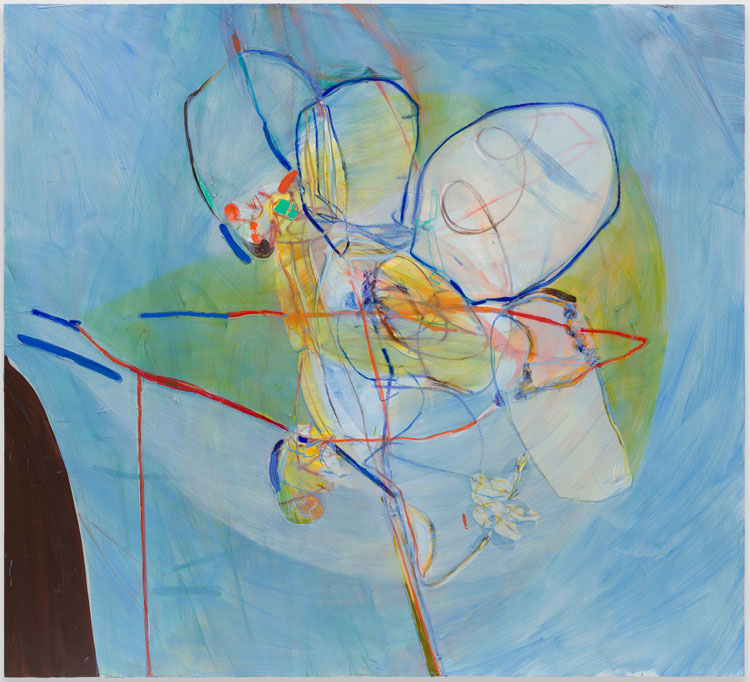
Jadé Fadojutimi. Birthday: Deathday, 2020. Oil and oil stick on canvas, 200 x 220 cm (78 3/4 x 86 5/8 in). Photo: Mark Blower, courtesy the artist and Pippy Houldsworth Gallery, London, © Jadé Fadojutimi 2021.
With a string of successful exhibitions, Fadojutimi’s career continues to flourish. Last year, at 27, she became the youngest artist to enter the Tate collection and is included in this year’s Liverpool Biennial. She is currently working towards solo exhibitions at the Hepworth Wakefield, ICA Miami and Fondazione Sandretto Re Rebaudengo in Turin next year. In this interview, the artist talks about her approach to painting, the place of drawing and writing in her practice, her obsession with Japan, her Liverpool Biennial exhibition and the pandemic’s impact on her and her work.
David Trigg: What first drew you to painting?
Jadé Fadojutimi: I didn’t go to galleries as a child and my family didn’t have much awareness of the arts, so it was never a part of my childhood. I had a very shallow and cliched introduction to art through high school, but I’ve always loved colour. Painting mentions a whole ocean of colour and I was so ready to dive in. Instinctively, I knew painting was the only option for me.
DT: And you went straight from school to the Slade School of Fine Art?
JF: Yes, I didn’t do a foundation course. I remember being excited to have the opportunity to focus and explore my enthralment with colour. But I found myself insecure about what I saw as a lack of knowledge about art, art history and contemporary artists compared with other students on the course. At first, this made me feel extremely vulnerable. Yet I was unwilling to divert my interests – anime, Japanese subcultures, Korean drama, soundtracks, clothing and colour – even though it tormented my self-esteem. Instead, I embraced these things and brought them into conversation with my paintings. It turned out to be a gift because I realised that art comes from life, which is something I celebrate in my painting now.
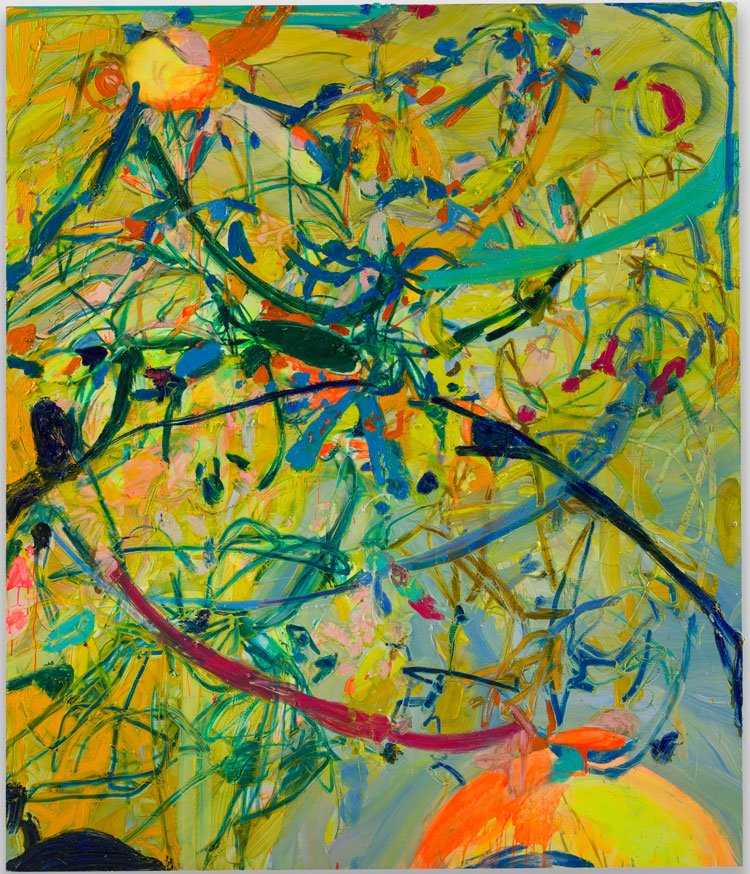
Jadé Fadojutimi. Even an awkward smile can sprout beyond the sun, 2021. Oil, oil bar and acrylic on canvas, 200 x 170 cm (78 3/4 x 66 7/8 in). Photo: Mark Blower, courtesy the artist and Pippy Houldsworth Gallery, London, © Jadé Fadojutimi 2021.
DT: At first glance, your paintings appear wholly abstract but they have figurative elements hidden within them. Can you talk about the tension between figuration and abstraction in your work?
JF: I see abstraction and figuration as opposite ends of the same spectrum and each work has its own place on that spectrum. My paintings derive their shapes, colours and patterns from clothing, anime, video games, soundtracks, childhood obsessions, memories, drawings, traumas, experiences and objects I have collected along the way. They are woven together into emotive environments that breed characters and forms. There are moments in some works that can be described as deliberate, but they are not preplanned; forms reveal themselves during the process of making. It’s stimulating exposing the subtleties of organic forms found along the process of painting and I relish manipulating their malleability, carrying them in and out of focus, making their recognition fragile. It lures in another veil of questioning, another ingredient for an already complex subject. I welcome an open-ended discussion with everything that gratifies me, in a hope to reveal the qualities that truly indulge me. My paintings thrive on isolating these indulgences and obsessing over them.
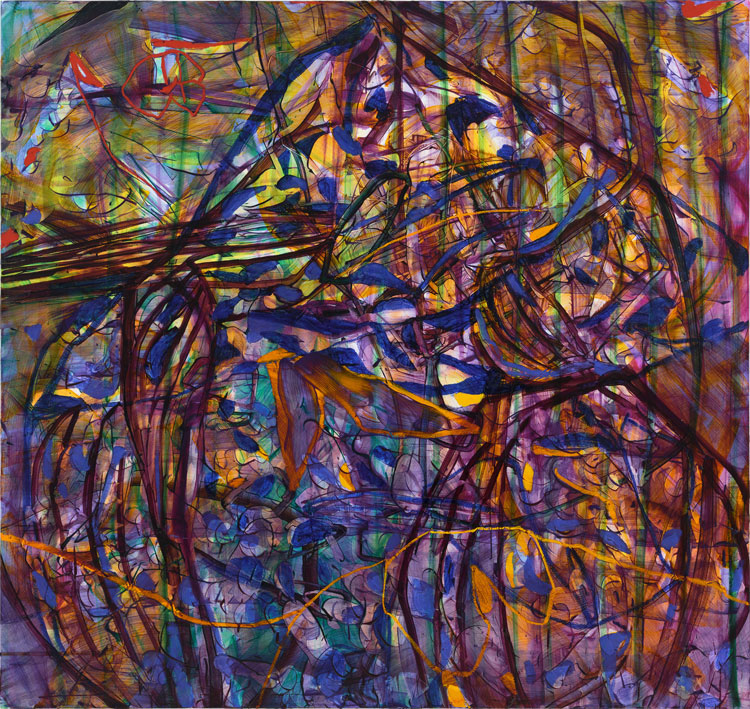
Jadé Fadojutimi. Cavernous Resonance, 2020. Oil and oil stick on canvas, 170 x 180 cm (66 7/8 x 70 7/8 in). Photo: Mark Blower, courtesy the artist and Pippy Houldsworth Gallery, London, © Jadé Fadojutimi 2021.
DT: Some of your works, such as Cavernous Resonance (2020), have a superabundance of marks and gestures while others, such as My Fissured Glow (2020), are much more restrained. Do you know what kind of painting you are going to make before you start, or do you intuitively feel your way in?
JF: I definitely intuitively feel my way through painting. However, working freely and intuitively thrives on absorbing visual information constantly. Every painting feels like a fresh opportunity to play. So, to be drawing, to be surrounding myself with my self-gratifications, as well as my drawings that I tape to the studio walls, means I am able to reach for anything while painting.
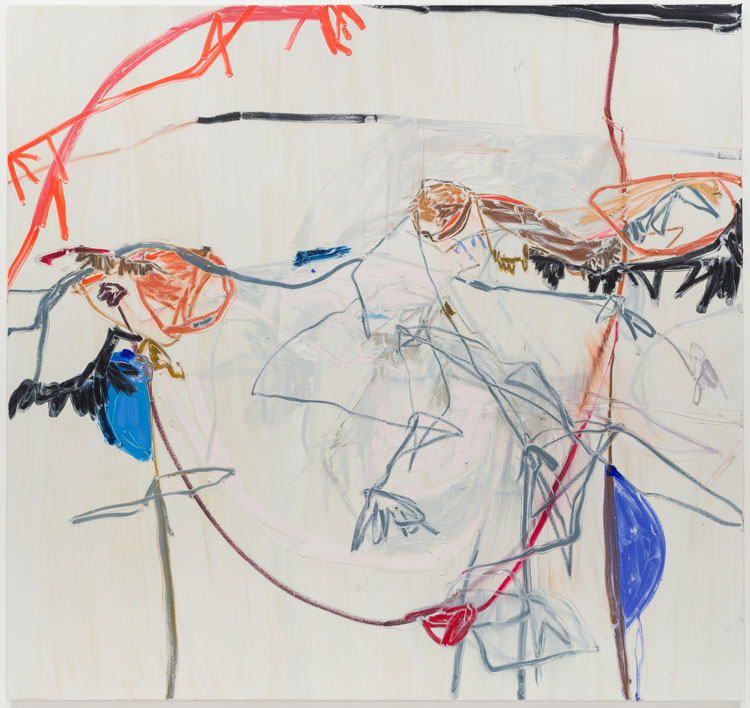
Jadé Fadojutimi. My Fissured Glow, 2020. Oil and oil stick on canvas, 170 x 180 cm (66 7/8 x 70 7/8 in). Photo: Mark Blower, courtesy the artist and Pippy Houldsworth Gallery, London, © Jadé Fadojutimi 2021.
DT: It sounds as if your studio is an essential element of your work.
JF: Yes. It is important that the space feels like my bedroom, a familiar environment that has always stirred my urge to create. I spoil myself with visual information and take from my surroundings like they’re a dictionary, a thesaurus, an atlas and an encyclopaedia. A wonderful byproduct is that the paintings and space flow in and out of each other, becoming one. They are constantly evolving and pushing each other, building an amalgamated environment that feels like a whole painting. I often refer to my studio as setting the stage for painting and everything within the space becomes important and a potential feature in a work, including other paintings. There is no pressure to predetermine any work and fear instantly evaporates when I enter the space.
DT: As well as vigorous mark-making, layering and glazing seem to be an important part of your technique.
JF: Painting is a sensory experience, so it’s hard to really describe the decisions I make along the way because it’s all about pleasure, which is subjective. But I spoil myself when I’m painting. I completely bathe in the conversations between colour, texture, line, form, composition, rhythm, marks and disturbances that allow me to gush. Since I have no systematic way of working, I find myself painting slightly differently each time. Those gushing moments are the essence of my decision-making. They are the mood of that moment captured as an event and celebrated.
DT: Do you paint late into the night?
JF: Yes, I do. That’s when my mind and energy are at their highest. It’s also when I’m most contemplative. Working when I am most energised translates materially into my canvases. I found my painting language by listening to and embracing who I am, so understanding the excitement of working at night is a part of that conversation with myself.
DT: You have said that your paintings are reflections of yourself and the objects that you surround yourself with. Would it be right to describe your works as autobiographical?
JF: I feel the term “autobiographical” only describes a fraction of my work. It is a natural byproduct of using painting to explore my identity. Nevertheless, as my paintings evolve, I am realising that they are becoming like a diary. I believe they will retrospectively reveal whether or not the autobiographical element is a vital part of their foundation.
DT: In your new book, Jesture, you are quoted as saying that you aim for “deep emotion, not deep description”. What did you mean by that?
JF: By that, I mean I’m always digging for myself in some way. I guess you could translate this experience as an attempt to delve as deep as you can, in desperation for that rare glimpse of your core. It’s a buried origin of yourself that’s immune to society’s rhythm. I have no sense of whether there’s a limit to its depth of truth, so it feels like an abyss of light that I’m trying to rescue so I can shine bright. It can often feel challenging to describe an abstract theory you’re still trying to grasp, and this is one of many wondrous endeavours that feeds an artist’s practice. For myself and my work, I reject the idea that this inhibits your ability to understand a concept that’s building. You are still capable of having a reaction, or impulse, to premature ideas. For me, this translates as deep emotion. I try to capture moments of my subconscious feedback, recording them as events in the form of painting, so I can confront, question and reflect on multiple experiences and hopefully reach the core of myself and practice – an identity that can feel unbearable to comprehend.
DT: Considering you pour so much of yourself into the work, do you experience a sense of vulnerability when you exhibit your paintings?
JF: If you decide to take on the task of questioning your “true identity”, you have to be willing to expose yourself to vulnerability. I’ve come to realise that my practice thrives on embracing vulnerability, as well as welcoming struggle. My 2019 exhibition She Squalls, at Galerie Gisela Capitain in Cologne, used a quote of mine for the press release that I think better describes this idea: “[Paintings] are my way of challenging society, questioning culture, debating identity and replacing language, becoming a reflection of their fragility. Their vulnerability is in their discussion and their power is in their vulnerability.”
DT: With this in mind, do you ever decide not to show works?
JF: If I choose not to show a work in an exhibition it’s not usually a fault of that painting, but because the conversation between the paintings in an exhibition is really considered. I am aiming for the most exciting debate and discussion the works can hold with each other. How a show is hung is incredibly important for the space. I have the opportunity to start a ripple of thought. I try to visualise and determine the overall environment people will walk into and set a pace for a visual debate. Sometimes I hold on to works because I want to keep the conversation just between myself and the painting.
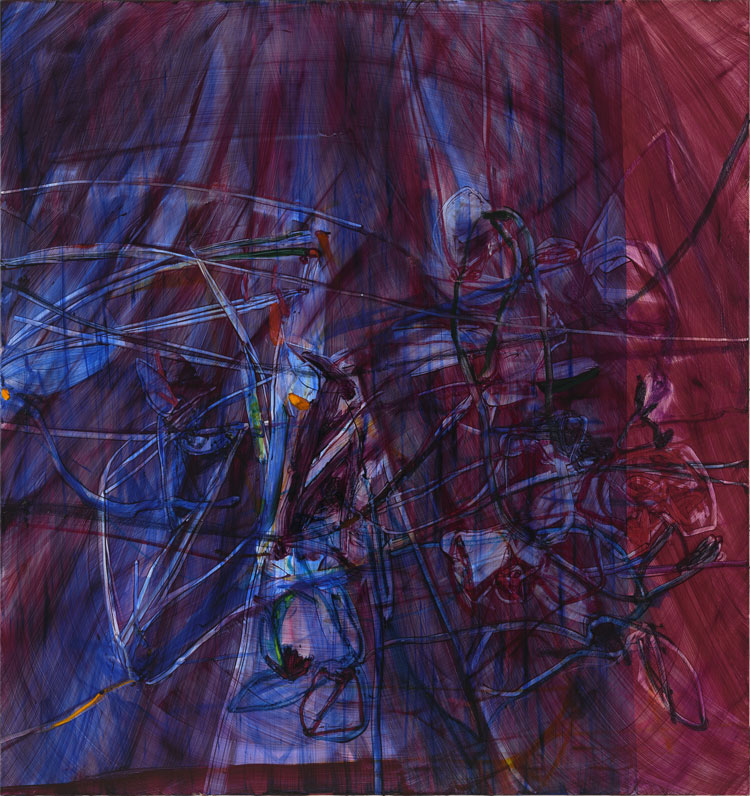
Jadé Fadojutimi. The Curtain Drops, 2020. Oil and oil stick on canvas, 180 x 170 cm (70 7/8 x 66 7/8 in). Photo: Eva Herzog, courtesy the artist and Pippy Houldsworth Gallery, London, © Jadé Fadojutimi 2021.
DT: Do you ever abandon works?
JF: Some paintings can make me feel stuck because it isn’t their moment. Sometimes you need to take a step back and recognise that you might need more room to grow as a painter, and that a work may be ahead of your current level of fluency in your own visual language. If I am still struggling with a work, I simply put it away, returning to it at a later date when I have developed my relationship with painting enough to have a conversation with it. So, in that sense, no painting is ever abandoned; they are works waiting to realise their full potential, like seeds that have yet to sprout. The Curtain Drops (2020) is a good example, which was an old unrealised work that I returned to two years later.
DT: What place does drawing have in your practice?
JF: Drawing has various functions. I find myself drawing as an appetiser for painting. I only paint when I have the urge, and that urge sometimes needs massaging. I usually draw while watching anime in the studio, until I yearn to create. And all that time, I’m thinking. The drawings become plays on colour, ideas, spontaneous thoughts, out of focus memories and objects in the room that function as notes for painting. Sometimes I can start a painting from a drawing, but the drawings never determine the painting. I try to keep as many drawings around me as I can, no matter how old they are, as I believe the longer we look at something the more it reveals. This is something that is true of painting, but I extend this thinking to all objects I bring into my life, including drawings.
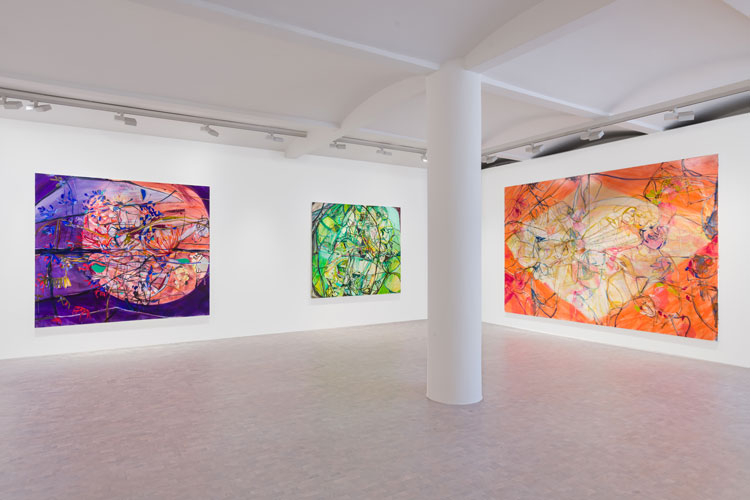
Jadé Fadojutimi, Jesture, 2020, Pippy Houldsworth Gallery, London. Photo: Mark Blower.
DT: You have recently started using oil sticks in your paintings, drawing directly on to the canvas. Are the distinctions between painting and drawing becoming less defined?
JF: Yes, I believe so. But why should there be such a large distinction between painting and drawing? Is drawing not a form of painting? Is painting not a form of drawing? I’m not sure who decides where the boundary lies between them, so I’ve been changing my approach, especially since the work is naturally going in the direction of becoming a hybrid between the two. For now, what seems to separate them are scale and surface, though I’m very open to fading those boundaries.
DT: Japan and Japanese culture have had a significant influence on your practice. What is it about the country that you find so attractive?
JF: Every country has its own melody. There’s something about the colour sensibility in Japan that I resonate with, as well as its fashion, soundtracks, landscape, language and storytelling in its animations. I’ve spent years immersed in anime. There was a time when my obsession meant it was the only thing I would do from morning to night. I treasure living in an escapist reality, so it’s only natural that this has had a large impact on my life and practice. As my paintings evolve, so does my relationship with the part of myself that fell in love with the country, the people I have met there and its multiple subcultures. I love going there to draw for months at a time when I can.
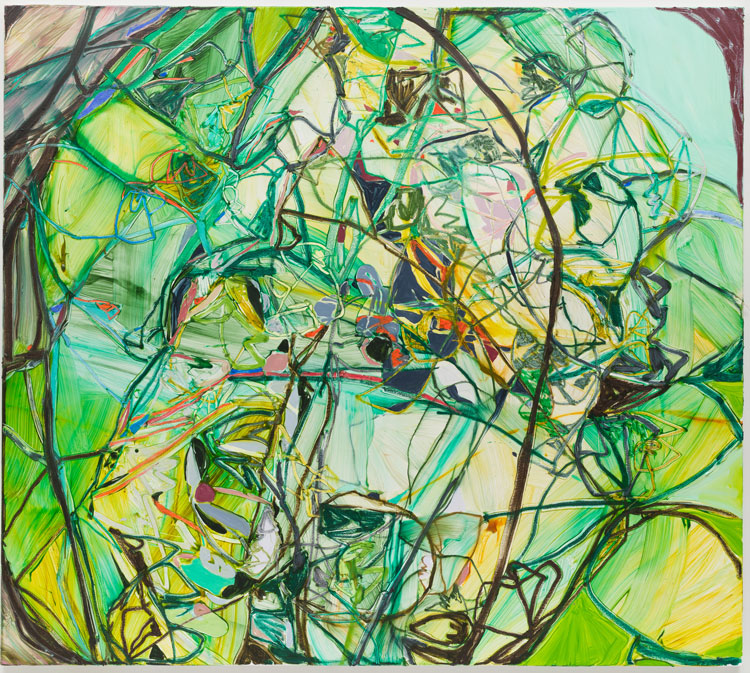
Jadé Fadojutimi. Mosaicked Utterance, 2020. Oil, acrylic and oil stick on canvas, 160 x 180 cm (63 x 70 7/8 in). Photo: Mark Blower, courtesy the artist and Pippy Houldsworth Gallery, London, © Jadé Fadojutimi 2021.
DT: You first visited Japan in 2016 as part of a student exchange programme while you were studying at the Royal College of Art. I was interested to read about the profound sense of not belonging that you experienced there. How did this impact your work?
FJ: That moment marked the start of everything for me – the moment I grasped my painting language. It had always been my dream to paint in Japan, but while I was there I started to recognise how much of myself was tied to London. I was forced to ask myself some really antagonising and provoking questions: why was it so hard to be somewhere I had dreamed of being my whole young adult life? How do I make work that is authentically me when I don’t know who I am? I hit rock bottom and, in my last few days in Japan, I began expressing my frustrations in the form of drawing, aggressively rebelling against my previous conflicts with myself.
When I returned to London, I embraced the opportunity to redefine my flaws and began celebrating them through a freshly reincarnated painting language. I started working as fast as I wanted, painting intuitively and not even caring whether or not the paint was dry. I asked paint to adapt to me, not the other way around, and I redirected my questions for society, beginning a journey with a series of questions that subsequently gave birth to my current practice. It was a real honeymoon period and I have been in a very healthy and exciting relationship with painting ever since.
DT: Your monograph, Jesture, contains a selection of your writings, which are printed on to colourful translucent pages. What is the relationship between your writing and your painting?
JF: My writings are thoughts on paper, thoughts that occur in the midst of painting, drawing or experiencing something that triggers a realisation about my practice. Usually, I find myself dropping my paintbrush to write something down, whether it be an idea or a concoction of phrases that tickle me. I see them as a reflex, like an intuitive mark in response to painting. I tend to write anywhere. A lot of it happens on paper lying around the studio, which I tape to the wall with my drawings. Sometimes I write among the drawings in my sketchbooks or in the notes section of my phone. I usually use what is most convenient and closest to me, so I don’t lose the thought. On occasion I record myself voicing an idea aloud on my phone. I find that detailing these thoughts in the process of making can help me grasp connections between myself and my practice.
DT: Your writings can be quite poetic.
JF: When people describe them as poetry, I speculate that maybe they are referring to their rhythmic qualities and choice of vocabulary. However, for me, that rhythm and language is part of my everyday conversation. I also feel that watching Japanese anime helped me embrace my way with language; I watch it in Japanese with English subtitles and I’ve always had an admiration for the language’s sensitivity, pace, and rhythm.
DT: Your interest in the possibilities of language is reflected by the titles you give your paintings. Where do these come from?
JF: Just as my writings are thoughts on paper, my titles function in a similar way. They operate as questions, not just for myself, the work and my practice, but hopefully also for others who choose to engage with the paintings. Titles come to me while I’m working on a painting, or when it’s finished, or sometimes even weeks after. However, it is rare that I title a work before I start. If a title occurs in the studio unrelated to a painting – adopting the essence of a quote for instance – it might become a show title. My 2019 exhibition at PEER is a good example of this: The Numbing Vibrancy of Characters in Play, which evolved into a short piece of writing embodying the relationship I had with the paintings I made for the show.
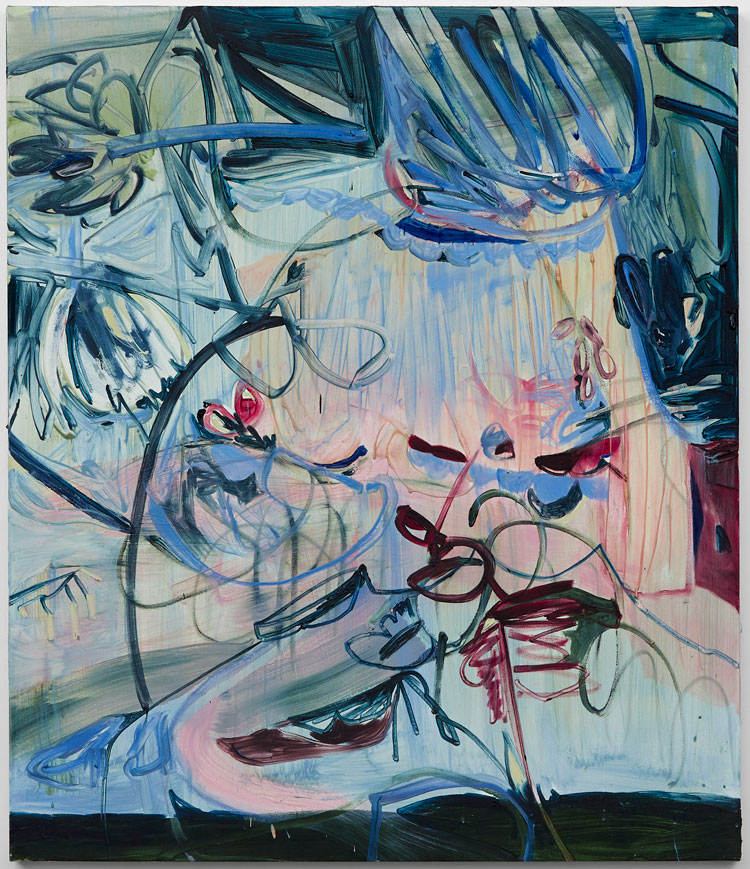
Jadé Fadojutimi. By the Window, 2017. Oil on canvas, 140.5 x 120.1 cm (55.3 x 47.3 in). Photo: Ben Westoby, courtesy the artist and Pippy Houldsworth Gallery, London, © Jadé Fadojutimi 2021.
DT: What are you showing at Bluecoat, for this year’s Liverpool Biennial?
JF: I am showing two very recent works alongside two older ones. One of them, By the Window (2017), has never been shown before; it references my relationship, or shall we say obsession, with my window, which accelerated my understanding of painting. Another, Let’s take a walk on a tangent (2018), has only been shown at Galerie Gisela Capitain in 2019, so people who didn’t have the opportunity to travel to Cologne now have a chance to see the painting in the UK.
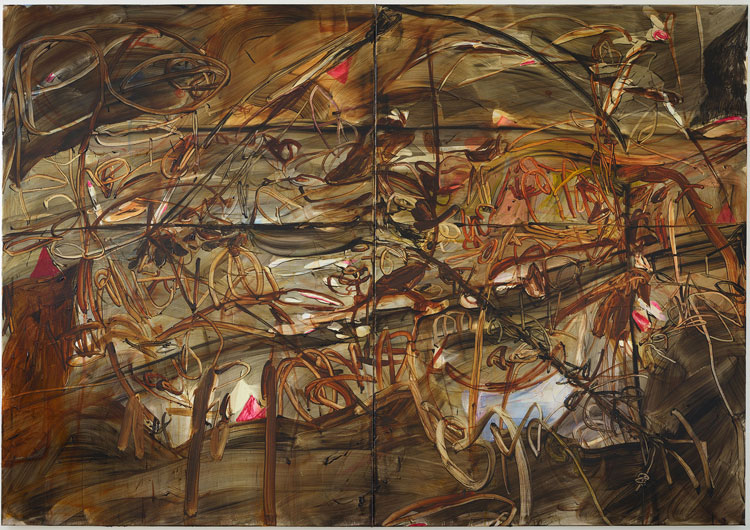
Jadé Fadojutimi. Let’s take a walk on a tangent, 2018. Oil on canvas, 210.5 x 301 cm (82.9 x 118.5 in) (diptych, overall). Photo: Simon Vogel, courtesy the artist, Galerie Gisela Capitain.
The Luna(tic) Effect (2020) is an exciting new development, introducing acrylic paint into my painting language. Then, finally, the youngest and most visually intense painting in the show is a complex gush of colour titled Even an awkward smile can sprout beyond the sun (2021). I am excited to witness the discussion between this selection of paintings as it will be the first time I have shown paintings from different stages of my practice in one space.
-Effect_2020_PH0826.jpg)
Jadé Fadojutimi. The Luna(tic) Effect, 2020. Oil, oil stick and acrylic on canvas, 200 x 300 cm (78 3/4 x 118 1/8 in). Photo: Mark Blower, courtesy the artist and Pippy Houldsworth Gallery, London, © Jadé Fadojutimi 2021.
DT: These new works, along with those shown in your exhibition Jesture, at Pippy Houldsworth Gallery in London last year, were largely produced during lockdown. How has the pandemic impacted you and your work?
JF: Oh, wow, where do I begin? I’m still in a daze from how much the pandemic has impacted myself and my work. It’s hard to find moments to process it all. In suddenly finding my surroundings limited, my thinking and imagination expanded beyond belief, which has ultimately enlarged my world. And it is still amplifying, swelling at a rate that is overwhelmingly exciting. I found a new studio. I stumbled upon my love for oil sticks. I spent time growing and nurturing my team. I found the occasion to invite my creative space into more of my home. I was writing more. I evolved my relationship with colour. I started a conversation with the work in regard to space. I started to become more fearless, welcoming more risk and thrill. With less distractions, I became a companion and collaborator with my inner thoughts and started entertaining my practice and life with endless ideas. My paintings, my life, and existence have become enriched.
• Liverpool Biennial 2021is running online and across Liverpool until 6 June 2021. Jadé Fadojutimi: Jesture is co-published by Pippy Houldsworth Gallery and Anomie Publishing.